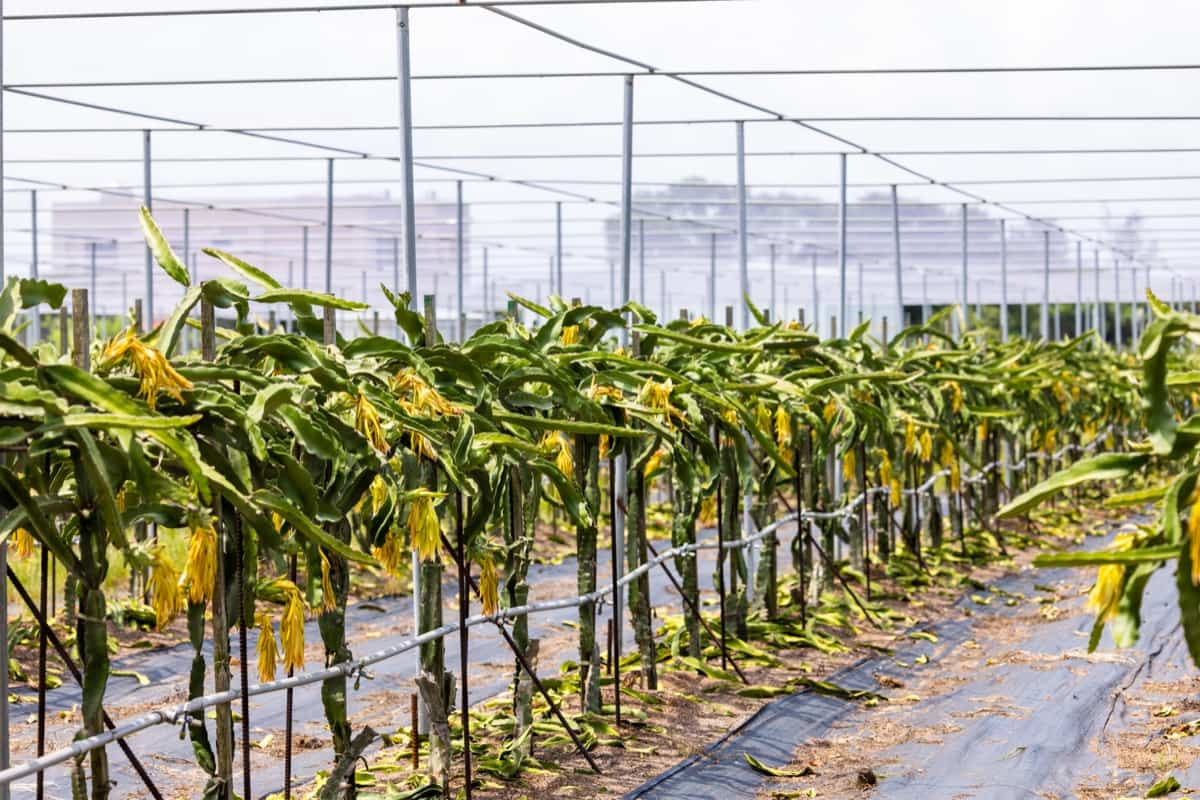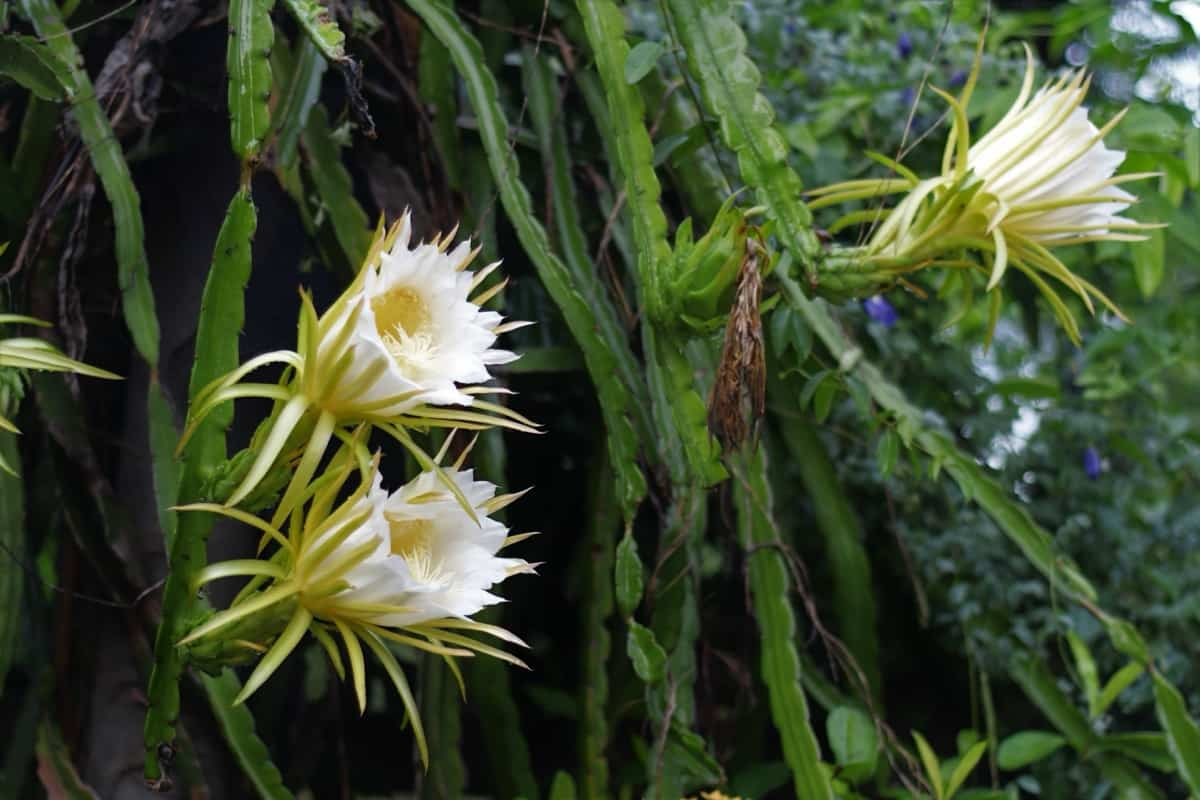Dragon fruit, also known as pitaya, is a tropical fruit crop cultivated primarily in Southeast Asia, Central and South America, and parts of the United States. It belongs to the cactus family and is known for its unique appearance. Dragon fruit plants produce large, showy, night-blooming flowers.

The fruit is typically oval or oblong, with pink, red, or yellow skin and white or else red flesh filled with small black seeds. Dragon fruit farming has gained popularity due to its economic potential and global demand. Establishing a dragon fruit farm can be rewarding but requires careful planning and investment. Here’s a step-by-step guide to help you get started.
Step-by-Step Guide to Establishing a Dragon Fruit Farm
Assessing the Feasibility of Establishing a Dragon Fruit Farm
- Assess whether there is a market for your produce, and if there is, determine its size and potential for growth.
- Calculate the initial investment required for setting up the farm, Assess your financial resources, and create a budget to ensure you have the necessary capital.
- Assess your knowledge and skills in dragon fruit cultivation. If you lack experience, consider hiring or consulting with experts in the field.
- Research local regulations and environmental conditions that may affect dragon fruit farming, such as zoning laws, water availability, and climate conditions.
Selecting the Ideal Location for Your Dragon Fruit Farm
- Dragon fruit thrives in a warm, tropical subtropical climate. It is sensitive to frost, so choose a location with a frost-free climate. The ideal temperature range is 18-35°C.
- Dragon fruit plants need plenty of sunlight. Select a location with at least 6 hours of direct sunlight per day.
- Well-drained soil is crucial for dragon fruit cultivation. Avoid areas prone to waterlogging, as this can lead to root rot.
- Dragon fruit plants are sensitive to strong winds, which can damage the plants and reduce fruit yield. Consider windbreaks or sheltered locations.
Preparing the Soil for Dragon Fruit Cultivation
- For establishing a dragon fruit farm, first, conduct a soil test to know the pH and nutrient levels. Dragon fruit prefers slightly acidic to neutral soil (pH 5.5-7).
- You may need to amend the soil with organic matter or specific nutrients based on the test results. Compost and well-rotted manure can improve soil structure.
- Dragon fruit plants benefit from well-drained soil, so consider planting them in raised beds or mounds to enhance drainage.
- Apply mulch to retain soil moisture and control weeds, but ensure good drainage around the plant’s base.
Choosing the Right Dragon Fruit Varieties for Your Farm: How To Identify Dragon Fruit Varieties
- Variety Selection: Dragon fruit comes in various varieties, with white-fleshed and red-fleshed options. Research and select varieties that are well-suited to your climate and market preferences.
- Self-Pollination: Consider self-pollinating varieties, as they can simplify pollination and fruit production.
- Disease Resistance: Look for dragon fruit varieties resistant to common diseases and pests in your area.
- Yield and Fruit Quality: Evaluate different varieties’ expected yield and fruit quality to meet your market demands.
In case you missed it: Best Practices for Propagating Dragon Fruit Plants

Types of Dragon Fruit Plants
- Hylocereus Undatus (White Flesh Dragon Fruit)
- Hylocereus Costaricensis (Costa Rica Dragon Fruit)
- Hylocereus Megalanthus (Yellow Dragon Fruit)
- Selenicereus Polynemus (Hawaiian Dragon Fruit)
- Hylocereus Ocamponis (Vietnamese Dragon Fruit)
- Hylocereus Polyrhizus (Vietnamese Jaina Dragon Fruit)
- Hylocereus megalanthus (Yellow Dragon Fruit)
Sourcing and Propagating Dragon Fruit Plants
For establishing a dragon fruit farm, You can purchase seedlings or cuttings from a reputable nursery or online supplier to source plants. To propagate, choose healthy cuttings, at least 12 inches long, and let them air dry for a few days to develop calluses. Plant them in well-draining soil or containers and provide support for climbing. Water deeply and sparingly and allow the soil to dry out between waterings. Maintain a warm, sunny environment and protect from frost. Dragon fruit can also be grown from seeds within the fruit, though this takes longer.
Planting and Establishing Dragon Fruit Cuttings or Seedlings: How to Plant Dragon Fruit In The Ground
How deep to plant dragon fruit cuttings? Plant cuttings or seedlings in a shallow hole, approximately 8-12 inches deep, ensuring the base is stable. Allow 10-20 feet of space between plants to accommodate their sprawling growth. Provide a trellis or support structure for the young plants to climb as they grow. Fertilize with a balanced, slow-release fertilizer during the growing season. Protect them from extreme cold, especially in the early stages.
Implementing Proper Irrigation and Water Management Techniques
Begin by understanding your plants’ specific water needs, considering factors like soil type, weather, and plant type. In general, during the growing season, water dragon fruit plants every 1-2 weeks, depending on soil moisture retention. More frequent watering may be needed in arid regions, while less is required in rainy areas. A drip irrigation system can maintain even soil moisture. Monitor soil moisture and adjust the watering schedule for optimal growth and fruit production.
Managing Pest and Disease Control in Dragon Fruit Farming: Dragon Fruit Pests and Diseases
Regularly inspect your dragon fruit plants for signs of pests or diseases. Utilize organic pesticides and biological control methods to minimize damage. Proper sanitation and pruning of affected parts can help control outbreaks. Encourage natural predators like ladybugs and lacewings. Maintaining optimal growing conditions, such as well-drained soil and proper spacing, can also prevent some issues. Staying vigilant and implementing integrated pest management strategies will help protect your dragon fruit crop from threats.
In case you missed it: Dragon Fruit Plant Fertilizer Requirements and Recommendations: For Best Yields

Harvesting and Marketing Your Dragon Fruit Crop
Harvest dragon fruit when they are fully ripe, typically when the fruit changes color and becomes slightly soft to the touch. Twist or cut the fruit gently from the plant. To maximize shelf life, handle them carefully to avoid bruising. Post-harvest, sort and package the fruit in well-ventilated containers. Create an appealing brand and consider selling through local markets, grocery stores, or online platforms.
To attract consumers, offer information on the fruit’s unique flavor and health benefits. Building a consistent supply and offering quality fruit will help you succeed in marketing dragon fruit. The average annual yield per pillar (3-4 plants) is about 15 kgs. Fruit weight varies from 300 to 500 grams. After two years of planting, the average economic yield is 10 tonnes per acre.
Frequently Asked Questions on Establishing a Dragon Fruit Farm
What is the Growing Period of Dragon Fruit?
The growing period of dragon fruit, from planting to harvest, typically spans about 6-12 months, depending on various factors such as climate, variety, and growing conditions. Planting is best done in the spring or early summer (March to June). Ripe fruit is typically ready for harvest from late summer to early winter (August – December).
Which Land is Suitable for Dragon Fruit?
Dragon fruit thrives in well-draining soil with a slightly acidic to neutral pH (5.5-7). The land should have good air circulation to prevent humidity-related issues. Avoid waterlogged areas, as dragon fruit is sensitive to overwatering. Choose a spot with protection from strong winds, especially for young plants.
How Many Times a Year is Dragon Fruit?
Dragon fruit typically yields fruit two to three times a year, with the potential for more in optimal conditions and with proper care.
How Much Dragon Fruit Per Acre?
A well-managed dragon fruit farm can produce around 7-10 tons of fruit per acre annually.
How Do You Increase The Size Of A Dragon Fruit?
To increase the size of dragon fruit, ensure proper nutrition, adequate water, and sunlight. Prune to reduce overcrowding and thin out excessive fruit to allow the remaining ones to grow larger.
How Many Kg of Dragon Fruit Per Plant?
Each dragon fruit plant can produce 5-6 kg of fruit per year when well-maintained.
What is the Best Climate For Dragon Fruit?
The best climate for dragon fruit is a tropical or subtropical climate with warm temperatures, minimal frost, and well-defined dry and rainy seasons.
How Much Water Does Dragon Fruit Need?
Dragon fruit needs consistent but not excessive moisture. Water every 1-2 weeks during the growing season, adjusting based on local conditions and soil moisture.
In case you missed it: How to Pollinate Dragon Fruit Flowers: Hand Pollination, Natural Pollination Methods, and Tips

How Long Does it Take a Dragon Fruit Cutting to Produce Fruit?
This plant needs at least five years to bear its first fruit when grown from seeds. If you grow dragon fruit cactus from cuttings, it only takes one to two years to produce its first fruit.
Conclusion
Establishing a dragon fruit farm requires patience and dedication, but with proper planning and ongoing care, you can have a bountiful harvest and a successful venture.
- Feed Your Flock for Less: Top 10 Tips to Save on Chicken Feed
- Ultimate Guide to Ossabaw Island Hog: Breeding, Raising, Diet, and Care
- Hatching Answers: The Top 10 Reasons Your Chickens Aren’t Laying Eggs
- Eggs and Economics: Breaking Down the Cost of Raising Backyard Chickens
- Defend Your Greens: Proven Methods to Keep Iguanas Out of Your Garden
- Ultimate Guide to Cinnamon Queen Chicken: A Comprehensive Guide for Beginners
- Ultimate Guide to California Tan Chicken: Breeding, Raising, Diet, Egg-Production and Care
- Ultimate Guide to Marsh Daisy Chicken: Breeding, Raising, Diet, and Care
- 10 Types of Chicken Farming Businesses You Can Start for Profits